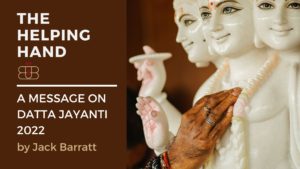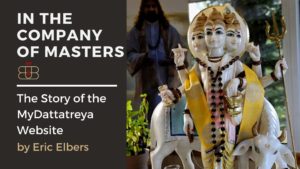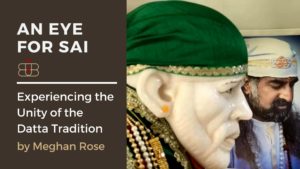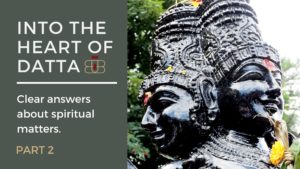Maharishi Nandinatha
Overview and Significance
The Nandinatha Sampradaya traces its beginning to at least 200 BCE. Its founder and first known spiritual preceptor was Maharishi Nandinatha. Nandinatha is said to have initiated eight disciples (Sanatkumar, Sanakar, Sanadanar, Sananthanar, Shivayogamuni, Patanjali, Vyaghrapada, and Thirumular), and sent them to various places to spread the teachings of Shaiva Siddhanta. Though some of these disciples were sent as far as China to spread the Shaiva Siddhanta philosophy of their Guru, the work of two is especially important.
Patanjali is known as the author of the Yoga Sutras, in which he codified the practice and philosophy of Yoga. This crucial text is one of the most widely quoted and respected texts on the practice of Yoga. Its translations are studied today in Yoga Centers throughout the world. Most of the mystical, Sanskrit vocabulary of Yoga teachings are first codified in this text. The Ashtanga Yoga (eight-limbed) process of Yoga comes from this text. The text contains a spiritual blueprint for controlling body and mind by degrees, detaching consciousness from its objects, and attaining Samadhi, the realisation of the Divine source.
Thirumular authored the Thirumantiram, which is a well-known and revered Tamil scripture. The Tirumantiram is still chanted in Tamil Nadu. It covers a wide variety of topics and illuminates much of the esoteric mystical insight of this Sampradaya. It illustrates the lifestyle and moral conduct advocated by this tradition. It provides much insight into the mystical meditations and tantras (techniques) valued by the Nandinatha Sampradaya. It places great emphasis on the repetition of the panchakshara (or five-lettered) mantra: Om Namah Shivaya.
Spiritual lineage: Maharishi Nandinath → Tirumular → → → Nameless Rishi from Himalayas → Kadaitswami → Chellappaswami → Siva Yogaswami → Satguru Sivaya Subramuniyaswami →Satguru Bodhinatha Veylanswami
The teachings of the Nandinatha Sampradaya, value highly the necessity of a living preceptor to carry the unseen, energetic essence of these teachings to devotees. The Nandinatha Sampradaya is a Siddha Yoga Tradition (‘Siddha’ means attainment literally), and its Gurus have often demonstrated great mystical abilities and wisdom. It is said that these teachers have realised their oneness with the Supreme God (they call ‘Shiva’) and have merged completely with this Divine source of all. With such realisation, it is said, comes limitless bliss and direct command of every power in the universe. There are many accounts of miraculous powers demonstrated by the Teachers of this lineage. It is taught that the aid of such a highly realised Siddha can greatly quicken spiritual practice. Some even say that without the diksha (initiation) of such teachers, the human instincts will always fail to lead to this highest Realisation.
The Nandinatha Sampradaya is maintained today by several groups stemming from Maharishi Nandinatha’s eight disciples. The Kailasa Parampara is based out of Kauai, Hawaii, the U.S.A., where a monastery and mandir (temple) is maintained. The Sannyasis (Monks) of this order continue to spread the teachings of this Sampradaya through the Himalayan Academy and the ‘Hinduism Today’ magazine. Satguru Bodhinatha Veylanswami is the living preceptor or the 163rd Guru Mahasannidhanam of the Kailasa Parampara of the Nandinatha Sampradaya.
The Himalayan Hindus of two thousand years ago lived a rustic life, close to the land, close to their spiritual roots, close to one another, on whom they depended for sustenance. Hamlets and ashrams were always built near a river, freshwater being central to survival. Their thatched cottages took many shapes, mostly round and rectangular, engineered with four or six posts inside, over which a sheet of woven branches, grasses, and leaves was layered. This pastoral life offered many opportunities for gatherings, especially in the ashrams, and the Himalayan Hindu holy men loved nothing more than to hold philosophical discourse and debates, often under the wide canopy of a ficus tree. Everyone would sit on the ground for these meetings. There were no books. Learning in those days was conveyed orally and committed to memory by the students. The spiritual elders had small mat-seats, or wooden tables called pitha, some six inches high, on which they would sit to guide the others and impart instructions to students of different ages. These rishis were often married men, not sannyasins. Some sannyasins also had disciples living with them, while others engaged in their spiritual meditation and other practices in strict seclusion.
In this Himalayan remote, there lived a great yogi known as Maharishi Nandinatha, a rare and illumined soul whose inner eye was opened to the perfection of the universe, a knower of Shiva, of the Self God within. He himself derived from a long line of Satgurus, whose names and biographies are lost, and thus he is regarded as the first known preceptor of the lineage known today as the Nandinatha Sampradaya, the Agamic tradition that Robert Hansen had discovered in Ceylon.
Nandinatha had for his direct disciples the four sages—Sanaka, Sanantana, Sanatana, and Sanatkumara—all bearing the title of Nandi. Besides them were Sivayoga Muni, Patanjali, Vyaghrapada and Tirumular (also known as Sundaranatha). All eight were the spiritual leaders of one of the initial Agamic schools and were known as Nathas. Of them, the first four received Lord Siva’s special grace and were commanded by Him to disperse themselves in the four directions, carrying the message of the Agamas. Once at their appointed destinations, they practiced intense yoga in the Agamic way—through sun and rain, hail and storm—and in time ascended to celestial status.
The yogis around Maharishi Nandinatha were well versed in the Shiva Sutras, whose aphorisms were regarded as the voice of Siva Himself—a puzzling, mathematically sophisticated set of fourteen couplets that seem to be about the Sanskrit alphabet, but on deeper reflection are a key to understanding the composition of the cosmos, showing how this language creates a mystical connection to the Divine from its very roots. From Kashmir Saivism to Shaiva Siddhanta, the early tantric traditions share a love of the Shiva Sutras, those obscure, arcane, mysterious verses that yogis study even in the 21st century to delve into the mystical apprehension of the universes, gross and subtle.
These fourteen sutras—revealed to Panini, who wrote them down as a kind of yogic science notebook for its time—emanated from the drum held in the raised right hand of Lord Shiva Nataraja. This science of sound and words remained a secret to most, for only the illumined could comprehend it, being unspoken knowledge directly from the Supreme Lord and beyond the reach of the ordinary mind.
Sages like Sanaka, Sanatana, Sanatkumara, Patanjali, and others were able to hear the transcendental sounds of Siva’s drum but could not grasp the inner, core meaning of the aphorisms. Legend says they approached Maharishi Nandinatha seeking an explanation. Moved by the sincerity of their search for this rare knowledge, the Satguru proceeded to elucidate the essence of the sutras. He offered twenty-seven verses, which are the only written teachings of this primal preceptor that have survived the tides of time, and thus form the oldest scriptural text from this Shaiva Siddhanta lineage. Terse and wise, it is known as the Nandikeshvara Kashika. Kashika means ‘the illuminator.’
It is said that Sri Nandikeshvara, as Maharishi Nandinatha is also known, accomplished the feat of explaining the inexplicable due to two things: his profound God Realisations, which gave him a oneness with Shiva within, and the completion of a difficult, some would say impossible, austerity, that of reciting the epic chant Sri Rudram ten million times.
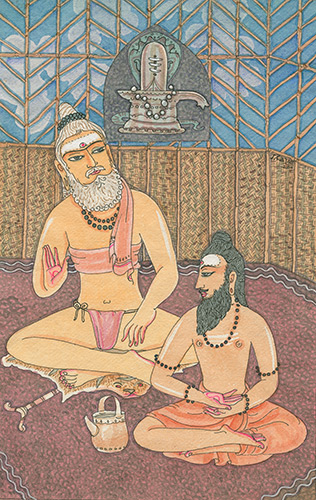
Teachings
Nandinatha’s Kashika is more a meditation than an explanation, a contemplation on thirty-six constituents of the universe, from the most subtle to the very earth on which we stand—Lord Shiva’s unfoldment of the cosmos through sound, specific sounds that are embedded forever in the letters of the Sanskrit language. These constituents, or tattvas, are at the heart of the cosmology of Shaiva Siddhanta, for in them can be found every level of consciousness, every element, every sense and color, every energy, vibration, and sound that exists. Shaiva Siddhanta speaks of 36 tattvas in all. Knowing the tattvas, one knows all.
The ancient texts are dense, convoluted, and opaque, for in those days, the secrets of yoga and inner consciousness were thought too precious to be openly expressed. So they were concealed in a special kind of language, like a cryptogram, assuring that only those who were qualified would have access; others would be confounded. Indeed, reading these texts today is confounding, as this glimpse into the far past, into the heart of the progenitors of yoga, the Himalayan masters prove.
Without the insights and commentary of knowers of God and Sanskrit pandits of the highest order, even these aphorisms, composed to elucidate the even more arcane fourteen Shiva Sutras, may defy understanding. For example: here is Nandinatha’s verse ten, followed by a commentary by Sabharathnam Sivachariar:
The Supreme Lord of all, denoted by the letter ®i (`), being in union with Shivashakti, denoted by the letter l®i (ऌ), whose form is of the nature of pure consciousness, enters Maya, activates it slightly, creates the world of movables and immovables and makes them expand. He does all this solely and absolutely, being One.
COMMENTARY: When it is said that the Supreme Lord is absolutely One only and that being in union with Shakti and by entering into Maya He creates the world, it is observed that the concept of the non-dual Lord gets affected. A seeming defect occurs in the concept of Advaita, as it is seen that, apart from the One Lord, there is the role of Shivashakti and Maya. In this verse and in the succeeding three verses it is explained that there is no such defect in the concept of a non-dual Lord. Âi (`) denotes the Supreme Lord and l®i (ऌ) denotes Shakti and Maya. As stated in the Shri Tantra, the mind-form of Shiva is Shakti, denoted by the letter l®i (ऌ). The last letter, ka (k[), the root word, means ‘brings out from the unmanifest.’ Shakti constitutes the form of the Lord, and Maya is a part of His form. A person is not in need of external help in making his bodily movements. So also, the Supreme Lord does not need external help to make His form move and act. This is expressed by the term Kevala. Apart from Shiva, there does not prevail a separate existence for Shakti and Maya.
A Selection of Sutras from Maharishi Nandinatha’s Philosophical Text:
- Compassionately willing to elevate the Siddhas such as Sanaka and others and to install them in the highest plane of consciousness related to the transcendental sound, Lord Nataraja, the absolute and unparalleled Lord of cosmic dance, sounded the drum (held in His raised right hand) fourteen times at the ending phase of the dance. The transcendental sounds emanating from the drum assumed the form of fourteen aphorisms and came to be known as the collection of Shiva Sutras. Now I proceed to explain the core meaning of those fourteen sutras.
- The Supreme Lord, who is eternally free from the association of three qualities, having entered the cosmic flux known as Maya, through His Conscious Energy, becomes all-pervasive, assumes the form of the worlds, and governs them.
- The letter a (A) is the first and foremost of all the 51 letters; it is self-luminous in nature. Because of its total identity with the Supreme Lord, it shines forth as the Supreme Ishvara Himself. Upon the union of the first letter, a (A), and the final letter, ha (h), the word aham is formed.
- The letter a (A) is of the nature of cogitability alone, being the unmanifest. The letter i (w) denotes chitkala. Because of its pervasive nature, the letter u (o) denotes Vishnu. That which is in the state of cogitability alone, having associated with chitkala, assuming a form for the sake of cosmic function, creates the worlds and enters into them by means of pervasive nature (Vishnu) and becomes cogitable as the Great Lord (Maheshvara).
- The Supreme Lord of all, denoted by the letter ®i (`), being in union with Shivashakti, denoted by the letter l®i (ऌ), whose form is of the nature of pure consciousness, enters Maya, activates it slightly, creates the world of movables and immovables and makes them expand. He does all this solely and absolutely, being One.
- Not even a slight difference can be seen between the moon and the moonlight and between a word and its meaning. So also, not even the slightest difference can be seen between the modifications and the One which sustains those modifications.
- Through His own energy, known as Chit-Shakti, and through His own will, the Supreme Lord makes the entire range of worlds unfold from the causal source known as Maya. The knowers of the scriptures realise that the letter ®i (`), which denotes the Supreme Lord, and the letter l®i (ऌ), which denotes Shakti, are the specific letters belonging to the category of neuter.
- The letters e (/), o (AaE), and ˆa (X) indicate the unified state of Maya and Ishvara. This kind of unification is seen in all the existents. Since He is the witness-consciousness for all the manifested things, it is ascertained that the Supreme Lord is solely One only, having nothing apart from His own existence.
- What is known as space evolves from ha (h). Air evolves from ya (ya). Fire evolves from ra (r). Water evolves from va (va). Thus declares the exalted King of Shivayoga through His Agamas.
- The five subtle elements from which the gross elements arise, namely, sound, touch, form, taste, and smell—evolve from the five letters ña (Va), ma (ma), ˆa (X), ∫a (Na) and na (na). Sound, touch, form, taste, and smell are the qualities of space, air, fire, water, and earth. The presence of these five elements is to be realised in all the existents.
- It has been declared that for all embodied beings, the five organs of knowledge—namely ear, skin, eye, nose and tongue—evolve from the five letters ja (ja), ba (ba), ga (ga), ∂a (z) and da (d) respectively.
- The Great Ishvara, the Absolute Lord of the universe, having well associated Himself with the three qualities—sattva, rajas, and tamas—which evolve prior to the creation of the worlds, constantly plays, presenting Himself in each embodied being. The three qualities—sattva, rajas, and tamas—evolve from the three letters ßa (xa), sha (Sa) and sa (sa).
- Lord Shiva is beyond all these tattvas whose evolution has been told so far. He is the Supreme One. He is the sole witness of all beings and their actions. He assumes a form fit enough to bestow His abounding grace on all beings. ‘I am the Self of all, and I am one with the supreme letter ha (h).’ Having imparted this final message, Lord Nataraja concealed Himself from the vision of the sages. Thus ends the Nandikeshvara Kashika.
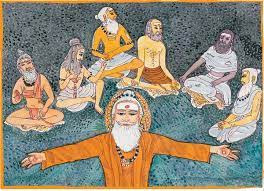
Contemporary Masters
- Satguru Bodhinatha Veylanswami, Kauai Aadheenam, Hawaii
Holy Sites and Pilgrimages
Kauai Hindu Monastery, 107 Kaholalele Road, Kapaa, Hawaii, 96746-9304
USA E-mail: [email protected]
Bibliography
Sources:
- The Guru Chronicles, the Making of the First American Satguru – Swamis of Kauai’s Hindu Monastery
- Dancing with Shiva, Hinduism’s Contemporary Catechism – Satguru Sivaya Subramuniyaswami


